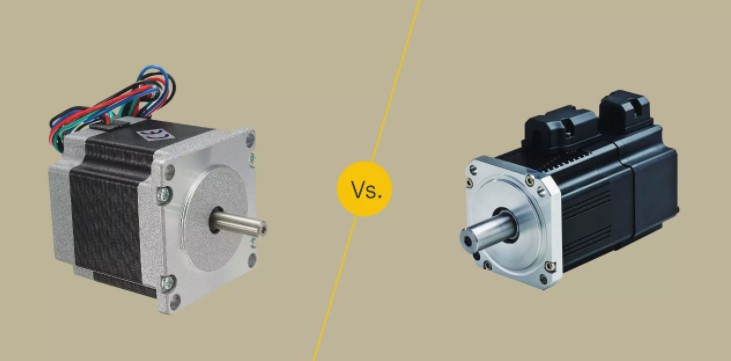
Privacy statement: Your privacy is very important to Us. Our company promises not to disclose your personal information to any external company with out your explicit permission.
Selecting between a servo motor and a Stepper Motor can be quite a challenge involving the balancing of several design factors. Cost considerations, torque, speed, acceleration, and drive circuitry all play a role in selecting the best motor for your application. We've reviewed their uses and strengths to help you pick the right motor for your application.

Stepper Motors
ü 50 to 100 magnetic pairs
ü Easier to control
ü More flexibility and precision
ü Better at low speeds
Servo Motors
ü 4 to 12 magnetic pairs
ü Fewer stops
ü May require a rotary encoder
ü Better at higher speeds
Stepper and servo motors differ in two key ways: their basic construction and their means of control. Both provide rotational force to move a system. Steppers have more steps, or positions the motor can hold.
Overall, servo motors are best for high speed, high torque applications. The design of the stepper motor provides a constant holding torque without the need for the motor to be powered. The torque of a stepper motor at low speeds is greater than a servo motor of the same size. Servos can achieve a higher overall speed, however.
Stepper Motors
ü More magnetic pairs, which means more steps
ü Easier to reach a specific step
Servo Motors
ü Fewer magnetic pairs
ü Less easy to go to a precise location
Stepper motors typically have 50 to 100 magnetic pairs of north and south poles generated either by a permanent magnet or an electric current. In comparison, servo motors have fewer poles, often 4 to 12 in total.
Each offers a natural stopping point for the motor shaft. The greater number of stops allows a stepper motor to move accurately and precisely between each and allows it to operate without any position feedback for many applications. Servo motors often require a rotary encoder to keep track of the position of the motor shaft, especially if it needs to make precise movements.
Stepper Motors
ü Easier to drive to a specific position
ü Find final position based on number of steps
Servo Motors
ü Harder to control accurately
ü Read final position based on adjusting current
Driving a stepper motor to a precise position is much simpler than driving a servo motor. With a stepper motor, a single drive pulse will move the motor shaft one step, from one pole to the next. Since the step size of a given motor is fixed at a certain amount of rotation, moving to a precise position is a matter of sending the right number of pulses.
In contrast, servo motors read the difference between the current encoder position and the position they were commanded to and adjust the current required to move to the correct position. With today's digital electronics, stepper motors are much easier to control than servo motors.
Servo Motors
ü Lower maximum RPM (around 2,000)
ü Less torque available at higher speeds
Stepper Motors
ü Can run at much higher speeds
ü Doesn't lose torque with RPM
For applications that require high speed and high torque, servo motors shine. Stepper motors peak around speeds of 2,000 RPM, while servo motors are available many times faster. Servo motors also maintain their torque rating at high speed, up to 90% of the rated torque is available from a servo at high speed.
Servos are more efficient than stepper motors, with efficiencies between 80-90%. A servo motor can supply roughly twice their rated torque for short periods, providing a well of capacity to draw from when needed. In addition, servo motors are quiet, available in AC and DC drive, and do not vibrate or suffer from resonance issues.
Stepper motors lose a significant amount of their torque as they approach their maximum driver speed. A loss of 80% of the rated torque at 90% of the maximum speed is typical. Stepper motors are also not as good as servo motors in accelerating a load. Attempting to accelerate a load too fast where the stepper cannot generate enough torque to move to the next step before the next drive pulse will result in a skipped step and a loss in position.
Selecting the best motor for your application depends on a few key design criteria for your system including cost, positional accuracy requirements, torque requirements, drive power availability, and acceleration requirements.
Stepper motors are better suited for lower acceleration, high holding-torque applications. Servo motors are capable of delivering more power than stepper motors but do require much more complex drive circuitry and positional feedback for accurate positioning. They often require gearboxes, especially for lower speed operation. The requirement for a gearbox and position encoder makes servo motor designs more mechanically complex and increase the maintenance requirements for the system.
If positional accuracy is essential, either the load on the motor must never exceed its torque, or the stepper must be combined with a position encoder to ensure accuracy. Stepper motors also suffer from vibration and resonance problems. At certain speeds, partially depending on the load dynamics, a stepper motor may enter resonance and be unable to drive the load. This results in skipped steps, stalled motors, excessive vibration, and noise.
LET'S GET IN TOUCH

Privacy statement: Your privacy is very important to Us. Our company promises not to disclose your personal information to any external company with out your explicit permission.

Fill in more information so that we can get in touch with you faster
Privacy statement: Your privacy is very important to Us. Our company promises not to disclose your personal information to any external company with out your explicit permission.